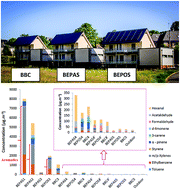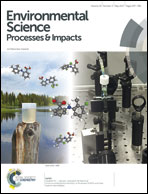Volatile organic compounds concentrations during the construction process in newly-built timber-frame houses: source identification and emission kinetics
Abstract
Building and furniture materials are known to be major sources of volatile organic compounds (VOCs) indoors. During the construction process, an introduced material can have a more or less long-term impact on the indoor air quality according to the building characteristics. In this study, field measurements were carried out at six construction stages in three energy-efficient timber-frame houses. Data analysis focused on the ten most abundant compounds found among an initial list of fifteen target VOCs, namely formaldehyde, acetaldehyde, hexanal, toluene, m/p-xylenes, ethylbenzene, styrene, α-pinene, 3-carene and D-limonene. The chemical compositions and concentration variation patterns were recorded. The results showed a high pollution count, with m/p-xylenes and ethylbenzene concentrations ranging from 1900 to 5100 μg m−3 occurring at the time of the structural work (representing more than 88% of the sum of the target VOCs). Emission tests done on a large number of materials used in the construction revealed that this pollution is due to the emissions from the polyurethane adhesive mastic used as a sealing material. The emission kinetics of polyurethane adhesive mastic was assessed alone and also within a material assembly reconstituting a room wall. The results showed that the superposition of materials led to a slowing down of the VOC emission process from polyurethane adhesive mastic, which explains the concentration decays recorded in houses during the construction process. At the final construction stage, the concentration levels were low for all compounds (the sums of the target VOCs were between 18 and 32 μg m−3), with the aldehydes (formaldehyde, acetaldehyde and hexanal) now becoming the major fraction in the chemical composition in the last stages of construction (representing 50–70% of the sum of the target VOCs). This is in agreement with the fact that the sources of aldehydes are the most numerous among the materials and have rather slow emission kinetics.



 Please wait while we load your content...
Please wait while we load your content...